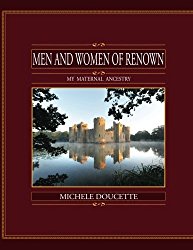Book 18: Men and Women of Renown: My Maternal Ancestry
Men and Women of Renown: My Maternal Ancestry is the first maternal genealogy tome from this author.
Genevieve Massignon, author of Les Parlers Français d’Acadie, sought to establish the origins of the French Acadian people based on linguistics, making the argument, in 1961, that many Acadians came from the Poitou region, south of Loudun, mainly because they were still speaking the old language, one rich and thick of Rabelais and Montaigne. She was also able to locate a number of records from the Poitou area that bore many of the same surnames found in early Acadie. Some of the villages in this area include Martaize, Aulnay, and La Chaussée. As a young man, Vincent Breau had been recruited as an agricultural worker for the fledging French colony of Acadie (possibly from the Poitou region of France). He settled at Port Royal (present day Annapolis Royal, Nova Scotia). Several years after arrival, he married Marie Bourg, a daughter of another colonist from the same region in France.
Never would I have thought, when I first began researching the Breau surname, that I would have ended up locating Catherine de Baillon, a 9th great grandmother, who, in turn would help me identify Charlemagne as a long lost ancestor. Many people of French-Canadian ancestry are able to trace their ancestry back to the Middle Ages, all courtesy of this woman. Catherine was born in Layes, near Montfort-L’Amaury in the Chevreuse Valley, Île-de-France, in 1645. Her parents, Alphonse de Baillon and Louise de Marle, were members of the minor French nobility. Coming to New France around 1669, as a daughter of the King, or Fille du Roi (meaning an immigrant bride that royal officials would send over to the colony to marry a settler), she married Jacques Miville dit Deschênes on November 12, 1669 at Québec City.
Jacques Guéret dit Dumont, born 1665, son of René Guéret and Madeleine Vigoureaux, was my 8th great grandfather. Born in the Parish of Canchy, in Normandy, by 1691 he had immigrated to Nouvelle-France (present day Québec) by way of La Rochelle. Three years later, on April 19, 1694, he married Marie Anne Tardif (the daughter of Jacques Tardif and Barbe d’Orange, also a Fille du Roi) in Beauport, Québec. It is widely known that the ascending lineage of Françoise de Méhérenc de Montmirel constitutes a medieval noble gateway with her grandson, Jacques Gueret Dumont, being the head of some Dumont families in New France.
Add to all of this, a smidgeon of some magick from the land of the Tuatha dé Danann, the Aos Sí (people of the mounds), the Druids, the faery folk, the wee folk, the leprechaun … and you have a most well-rounded lineage. The surname Feeley comes from O’Fithcheallaigh, a name that meant chess player. Chess was a game that was much in vogue in ancient Ireland. The clan originally belonged to Corca Laoidh (South-west Cork) and held territory in Ardfield and Clonakilty. By the 17th Century, branches of the sept had become established in north Connacht and Donegal. The first recorded spelling of the family name is shown to be that of Donal O’Fihelly, which was dated circa 1500; a writer of Irish Annals, known as The Last Warrior King, during the reign of King Henry V11 of England. Surnames became necessary when governments introduced personal taxation (which lead to poll tax that we still have today). Throughout the centuries, surnames in every country have continued to develop, often leading to astonishing variants of the original spelling, including the English name Field.
630 pages and 4066 footnotes


